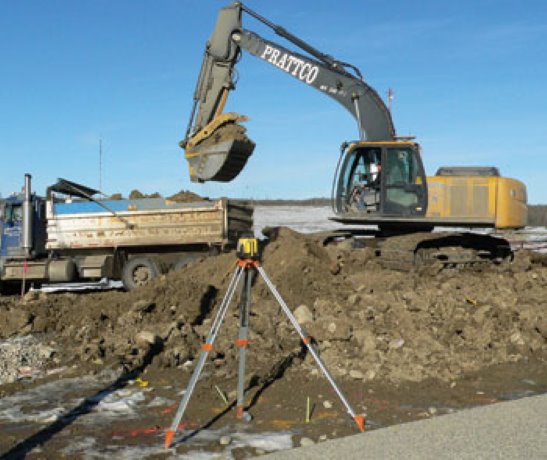Rising fuel costs and a search for competitive advantage are leading an increasing number of earth moving contractors to purchase heavy equipment that has been fitted out with high-tech machine control guidance systems or retrofit the equipment they already own with the technology.
Rising fuel costs and a search for competitive advantage are leading an increasing number of earth moving contractors to purchase heavy equipment that has been fitted out with high-tech machine control guidance systems or retrofit the equipment they already own with the technology.
The systems don’t come cheap – they start at about $10,000 and go up from there – but vendors say they can increase equipment productivity and give contractors a leg up on rivals in a competitive market with tight bidding estimates.
“You don’t have to jump in and out of the cab to take measurements manually,” said Eugene Bleau with Calgary-based Prattco Excavating Ltd.
“The system tells you where to make the cut. You know where you’re at without getting out of the machine.”
The company has been using a global positioning systems (GPS)-equipped machine control system for about three years.
Prattco specialize in light commercial site preparation and residential basement excavation.
In 2009, Hemisphere GPS Inc., a Calgary-based developer and manufacturer of global positioning systems, installed a GPS guidance system on Prattco’s John Deere 200D LC excavator.
Like all application-specific technologies, the different systems tout different features.
But, what they all have in common is that they make use of advanced technology.
This includes lasers, optical and inertial technologies, wireless communications and application-specific software to give heavy equipment operators a more accurate, mathematically-determined visual indication of the bucket or tool position relative to the desired grade than the naked human eye could provide.
“It makes the equipment more intelligent and more productive,” said John Dodds, secretary-treasurer with the B.C. Chapter of Associated Equipment Distributors.
“I expect to see a steady stream of more products with more applications in the future.”
Three-dimension machine control systems incorporate GPS, a space-based satellite navigation system that provides location and time information wherever there is an unobstructed line of sight to four or more GPS satellites.
The systems compare the position of an equipment’s cutting edge to a three-dimensional design to control the lift and tilt of a machine’s cutting edge, blade or bucket.
The site design, typically created by a surveyor or engineer, can be imported from the original design file into the machine’s GPS display.
Most GPS guidance systems also have the ability to allow the operator to define a specific grade elevation or grade angle without a specific design.
Two-dimensional systems, which do not have GPS, use lasers, sonic technology or slope sensors to control a piece of equipment’s cutting edge.
Machine control systems, especially the 3D variety, are more accurate than the naked human eye, which enables them to enhance the accuracy of most operators.
Some systems have tolerances as small as two or three centimetres.
Because the systems know when operators have strayed from the design grade, and will alert them to that fact, surveying and material costs can be significantly reduced.
Doug Pratt, president of Prattco, said the company saves 1.5 hours of operation every day the excavator is in the field.
Before the system was installed, the company averaged eight hours per basement excavation, but that decreased to 6.5 hours after the retrofit.
Prattco translates this into $75,000-$100,000 of additional revenue opportunity per year, per machine, based on having more time available to complete additional jobs.
According to a 2010 survey of U.S. contractors by Clear Seas Research, the greatest benefit of machine control technology was the ability to complete jobs faster and within budget.
Also high in the rankings were reduced staking and fewer rework corrections, the ability to see data on the screen in the cab and a higher level of accuracy over conventional methods.
Other benefits noted by survey participants included increased safety.
There are several brands of machine control systems for the earth moving industry.
According to Ed Picher, technical sales rep for Sitech Western Canada in Coquitlam, the three most popular systems in North American are Leica Geosystems, Topcon Positioning Systems Inc. and Trimble Navigation Limited.
Trimble, which is represented in western Canada by Sitech Western Canada, makes machine control systems for graders, excavators, dozers, skid steers, back hoes, paving and milling machines.
Picher said that about 60 per cent of the machine control systems that Sitech Western Canada sells now are part of new equipment purchases and the remaining 40 per cent are retrofits.
“It goes in cycles,” he said.
“When the construction industry is busy, we sell more new equipment systems and when the industry is slow and there’s less money, we sell more retrofits.”











Recent Comments
comments for this post are closed